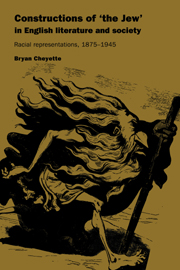Book contents
- Frontmatter
- Contents
- Preface
- Acknowledgements
- 1 Introduction: semitism and the cultural realm
- 2 The promised land of liberalism: Matthew Arnold, Anthony Trollope and George Eliot
- 3 Empire and anarchy: John Buchan and Rudyard Kipling
- 4 The ‘socialism of fools’: George Bernard Shaw and H. G. Wells
- 5 The limits of liberalism: Hilaire Belloc and G. K. Chesterton
- 6 Modernism and ambivalence: James Joyce and T. S. Eliot
- 7 Conclusion: semitism and the crisis of representation
- Bibliography
- Index
6 - Modernism and ambivalence: James Joyce and T. S. Eliot
Published online by Cambridge University Press: 19 October 2009
- Frontmatter
- Contents
- Preface
- Acknowledgements
- 1 Introduction: semitism and the cultural realm
- 2 The promised land of liberalism: Matthew Arnold, Anthony Trollope and George Eliot
- 3 Empire and anarchy: John Buchan and Rudyard Kipling
- 4 The ‘socialism of fools’: George Bernard Shaw and H. G. Wells
- 5 The limits of liberalism: Hilaire Belloc and G. K. Chesterton
- 6 Modernism and ambivalence: James Joyce and T. S. Eliot
- 7 Conclusion: semitism and the crisis of representation
- Bibliography
- Index
Summary
Ulysses is a highly romantic self-portrait of the mature Joyce (disguised as a Jew) and of his adolescent self – of Bloom and Stephen.
Wyndham Lewis, Time and Western Man (London, 1927), pp. 75–113Every nation, every race, has not only its own creative, but its own critical turn of mind; and is even more oblivious of the shortcomings and limitations of its critical habits than those of its creative genius.
T. S. Eliot, ‘Tradition and the Individual Talent’ (1919), The Sacred Wood (London, 1920), p. 47INTRODUCTION
From radically differing perspectives the modernist writers, James Joyce and T. S. Eliot, both undertook a comprehensive critique of the late Victorian modernizing assumptions behind Matthew Arnold's Culture and Anarchy. Joyce's Ulysses (1922) includes a cluster of ‘Hebraic and Hellenic’ representations and employs them to explode any notions that an Arnoldian grand synthesis of these oppositions is equivalent to the progress of civilization. The modernist techniques at the heart of Joyce's novel constructs an indeterminate ‘Jewgreek’ – Leopold Bloom, a modern-day Odysseus – who cannot be ‘known’, unproblematically, by any received set of criteria. In this way, Joyce makes him the site on which to challenge the reader's faith in a literary text to order ‘reality’. It is precisely the instability of ‘the Jew’ as a racial and cultural signifier that Joyce, throughout his novel, exploits to undermine any dominant discourse whether it be religion, nationalism, or Arnoldian liberalism.
- Type
- Chapter
- Information
- Constructions of 'the Jew' in English Literature and SocietyRacial Representations, 1875–1945, pp. 206 - 267Publisher: Cambridge University PressPrint publication year: 1993



